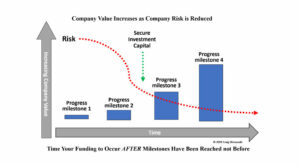This is the third in a series of seven common entrepreneurial mistakes, and how to fix them.
 Although the context will be biotech entrepreneurs, these principles apply to all entrepreneurs.
Although the context will be biotech entrepreneurs, these principles apply to all entrepreneurs.
A third common mistake of entrepreneurs is that as they grow their business, they haphazardly, although unintentionally, put together a disorderly array of foundational documents that impedes their ability to raise capital from more sophisticated investors in the future. These documents are usually piecemealed together after they were needed and often by various attorneys, and some were do-it-yourself. The result is loosely assembled or completely omitted founder agreements, an inadequate technology license agreement, missing key employee agreements failing to ascribe value to the organization from its founders and stakeholders.
Requisite documents may have simply been omitted, or more often if they exist, they contain conflicting language with other documents. As a result, there may be ownership issues in poorly written foundational documents. There may also be ownership uncertainty because of verbal agreements made to individuals who could come back and claim rights. If multiple founders started the company, one may no longer be working to advance the business, yet they walked away with a large chunk of equity with no agreement for reacquiring those shares. All this creates unnecessary obstacles to raising capital in the future.
Other problems can include:
- A license agreement that does not allow the rights to sell the technology (business) without prior approval from the licensee
- Missing employment agreements that ensure investors that key employees will not be leaving to start a competing business after their investment
- Inappropriately structured funding agreements with angel investors
- Missing invention assignment agreements from key employees that are inventors of the technology
In many cases, institutional investors may simply walk away from deals that require too much renegotiation because of these uncertainties and the potential pitfalls.
Why This Frequently Occurs
This mistake happens more frequently than not, simply because early-stage entrepreneurs are solely focused on what they think are the most urgent things. Most early stage entrepreneurs become fixed on seed fundraising and incrementally advancing their product concept but neglect consideration of other critical aspects of the business. Progress is made, but nevertheless this is like plugging a hole in your boat to prevent it from sinking, not realizing it is headed toward a waterfall.
This piecemeal, deal-with-it-when-you-need-it, and do-it-yourself approach may suffice for a short period of time. Unfortunately, as your business gains momentum and interest from sophisticated institutional investors, there will be grave concern over this legal quagmire and the lack of clear ownership of the assets and legal structure of the organization. Entrepreneurs need to recognize that these corporate hindrances impact your ability to raise future capital and grow your business. Think of this as watching a building grow atop a foundation that later needs to be torn up and re-laid in order for the structure to be finished.
How to Avoid this Mistake?
Entrepreneurs must realize at the outset that there are four Essential Components of a business that each must be simultaneously advanced in order for optimal chances of success. These include:
- Product Development
- Market Development
- Financing Development
- Corporate Development
All entrepreneurs understand the need for the Product Development component and they are usually deeply entrenched in this. However, the other three components are equally essential in order to build a successful business. In this piece we are focusing on the less recognized “Corporate Development” component of the business.
In order to have the best chance of success, entrepreneurs need to identify key milestones within each of these four development categories and manage and monitor reaching each of them. Be sure to select milestones that demonstrate to investors a reduction in risk for each of these components.
In order to create an overall strategic business strategy, you will need the help of an experienced and seasoned start-up corporate attorney. You need to find one that is experienced with development-stage companies in your sector, someone who is supportive of entrepreneurs, and one whom you can establish a good working relationship. Realize you will be paying for experienced business and legal advice, not for someone who fills in blanks in boiler plate documents. As a general rule, look for senior partners in small to midsized firms rather than someone in a mammoth law firm that may relegate your work to junior or novice individuals. There are other attorneys you will likely need help from during your business venture such as a Patent Attorney, and possibly a Securities Attorney. For more information on finding and hiring an attorney, review the article I wrote for Nature Biotechnology’s Bioentrepreneur titled: “Why You Need a Lawyer”
A good corporate attorney is someone who will assist you with the overall impact and alignment of each of the following (and more) to your overall business strategy:
- Choosing the right legal corporate structure and at appropriate stages
- Properly securing the rights to your company name, trademarks and product names
- Negotiating technology license agreements with rights that are needed to sell the company in the future
- Creating founder’s agreements and founders’ stock or options with buy back rights
- Creating key employee agreement with non-disclosures and assignment of inventions to company
- Establishment of stock option plans
- Properly constructing financing and shareholder agreements
Documents outlining the above are foundational because they define your corporate entity, its ties to licensed entities, founders and employees, describing various restrictions and rights posed on your organization.
If You are in a Problem Situation Now
If you realize that you have created a legal document mess, in order to repair it there must be a process of creating new documents, obtaining required signatures from past shareholders and other potential stakeholders who could possibly claim rights to some part of the business. All the more important to find a good corporate attorney as described above and work out some arrangements with them if you do not have a large budget. Some attorneys will help and move part of their fees tied to the next funding, or possibly even exchange for participation with stock options. If you find yourself in this situation, recognize that in order to secure subsequent financings, some of your agreements may need to be renegotiated or canceled which takes time and effort in order to move forward. Remember, it is not too late to begin.
Summary
In order to be successful, entrepreneurs should ensure they advance each of the four Essential Components of a business simultaneously. Stephen Covey speaks about the “Urgent/Not Important” quadrant displacing the “Important/Not Urgent” quadrant of activities in his book “7 Habits of Highly Effective People.[1]” Be sure that you do not simply focus on the urgent, but also the important. Allocate time and focus to the Corporate Development component of your business. Set value enhancing milestones in each of these four development areas and check monthly to be sure you are engaged in activities that move each of these forward simultaneously. By consistently and progressively reaching incremental milestones in each of these areas, you will find that your business will be viewed with interest by investors. Be sure to find a good attorney who has experience in your sector and at your stage of business, whom you get along with and gives you good advice. They are extremely valuable for their strategic business advice and as a trusted advisor rather than someone who provides you with just legal templates. Focus your attention on all four areas of business for your best opportunity for success!
© 2016 Craig Shimasaki
[1] Simon & Schuster; 25th anniversary edition (November 19, 2013)







